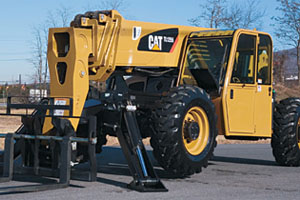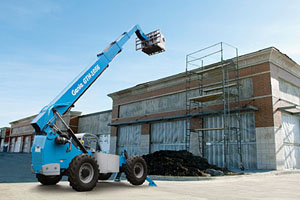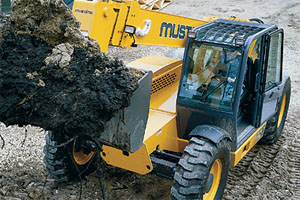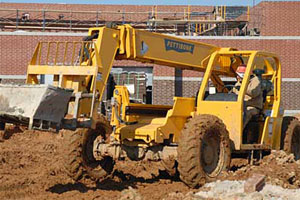July 16, 2007 8:52 AM CDT

The TL-Series also features full hydraulic power — even at low engine speeds — for precise load placement and reduced fuel consumption. Further, all models offer three steering modes — two-wheel, crab and circle steer — which allow the operator to maneuver the machine in tight places and to more easily place loads when access is partially obstructed.
To control everything, the telehandlers employ a single joystick, with a separate control lever to operate auxiliary hydraulic functions. Such technologies, which are offered by many of today's telehandler manufacturers, are quickly becoming requisite features for savvy contractors.
"The new telehandlers are tailored to the needs of contractors in North America, and they are fully supported by Caterpillar — parts inventory, service, warranties and Cat Financial programs," said Caterpillar's Scott Cooper last December in announcing the availability of the TL-Series.
Available TL-Series attachments include: material handling buckets; fixed, rotating and sideshift carriages; pallet forks, lift hooks, truss booms and material handling arms.

Features and options that are available on these telehandlers — such as rear axle stabilization systems, four-wheel steering, load-sensing hydraulics, tier III engines, axle-mounted stabilizers, foam-filled tires, frame leveling and more — are all technological advancements, which have made the industry what it is today: a highly valued one, Webber said.
"Just imagine how a job site would run without these advancements," he said. "It took a while for the industry to get to this point, but the construction sites around the world are reaping the rewards of these advancements today."
To further explain the telehandler's importance on a job site, Webber compared construction sites to an operating room, saying efficiency is critical to the success of the operation. "The surgeon isn't running around looking for tools or materials. He's doing exactly what the hospital has hired him to do," said Webber. "His staff — in this case, the smaller telehandler — ensures that the surgeon has everything he needs at the right place and at the right time. The goal is to successfully complete the procedure as safely and quickly as possible — kind of like the goal of a construction site."
And this trend toward divergent or niche machines, Webber said, is simply in response to customer demand. "We are seeing a slight divergence into the larger and smaller telehandlers. ... I believe that the industry, as a whole, is getting smarter about how they purchase and rent telehandlers," he said.
"We wouldn't have been able to achieve success without fundamentally understanding the customer's needs," Webber continued. "Our position has always been to manufacture the most valued telehandler in the industry.
"Today, we mostly offer mainstream model sizes. However, Genie telehandlers offer more than mainstream performance. Take, for example, our GTH-5519. It really can be considered the compact telehandler that took the industry by storm with its impressive combination of lifting performance and compact size [5,500 pounds to 18 feet, with an operating weight of 9,990 pounds]. Some would have said this machine was a niche machine only a few years ago, but today it's as popular as any other telehandler we sell."

"The Mustang 519 is a true compact unit, well suited for both rental and retail," said Doug Snorek, Mustang marketing manager. "For small- to medium-sized contactors, this is an ideal, entry-level machine."
The company's slightly larger 634 compact telehandler also is marketed to mason contractors. This Mustang features a 6,000-pound capacity and a 34-foot lift. Additionally, it is offered with short, but wide, 15-inch tires. "Because it weighs 5,000 pounds less than its competitors and has wider, flotation tires, you can get into a lot muddier situations, which brick masons often work in — especially this time of year," said Steve Challoner, Midwest region sales manager for Mustang. "And you can still go up more than 30 feet."
Like many other heavy equipment manufacturers, Mustang offers a wide selection of attachments for its machines, including a remote boom control, which allows one worker to complete inspections and other work. "You can put on a standard, OSHA-approved work platform onto the forks, and you can use this remote boom control," said Challoner. "You don't have to have an operator in the seat; the worker on the platform can control the boom. He can get up at height in this work platform and work along the envelope in front of a telehandler."
Mustang also has introduced a rotating work platform, which swings parallel with the machine up to 180 degrees. Operators can park next to a building and get a much greater worker area. The system is compatible with the remote boom control, and basically works as a telehandler and an aerial work platform, Challoner said. The sky is the limit on how much time it saves, he added.

"We've seen quite a jump over the last decade in the number of [10,000-pound capacity] machines going into the market," he added. "The biggest thing is the telehandler being a versatile, all-around tool."
Pettibone manufactures two general series of telehandlers: the Extendo Series and the Traverse Series. Blondeau said the Traverse machines suit mason contractors best, offering 70 inches of horizontal transfer, or boom travel. "Without maneuvering the machine, they can raise the boom, move it into position, unload, and retract without ever having to reposition. The reach is unbelievable — very precise handling."
Speaking of precision, Pettibone's telehandlers can be equipped with a Qualcomm GlobalTRACS GPS System. The unit can track where the machine is, as well as hours of operation. It also keeps track of maintenance and notifies users when the next scheduled service is due. "It takes a heck of a load off the service guys, and the guy renting the machine, to know exactly where it is at any one time," said Blondeau.
When Pettibone first introduced its GPS system, it was offered as a standard feature, but recently was made an option. Blondeau explained, "If you have a smaller contractor, they generally know where their machines are ... but some of our customers, when they're renting 30 or 40 machines — whether it's a dealer or an end-user with that many units — it's a great tool to have."
There are additional technologies on which Pettibone is working to make its telehandlers better and easier to use. Blondeau expects them to be ready this year, but would not discuss what was being developed. He did admit, however, that a new, large telehandler might be among the forthcoming innovations.
As is evident by the manufacturers and machines described here, the industry always is seeking new ideas to make the customer more productive. In this market, there seems to be no such concept as too many choices. In fact, with more choices, every mason contractor should be able to find the exact machine his or her crews need.
And if, for some reason, your needs are not being met, the manufacturers encourage you to notify them. Each of them said that their equipment and technological advancements are driven solely by customers' needs and wants — your input drives their innovations.
Choices, Choices, Choices
Pardon the pun, but there has been quite a bit of shifting and movement within the telehandler market during the past few years. From specialized, larger and smaller machines, to new attachments, remote control systems and GPS, the market is changing and growing in many ways. What this growth means for mason contractors is more choices and, ultimately, better job performance.
Let us help to sort through some of the industry's newest offerings.

The TL-Series from Caterpillar, Inc. features full hydraulic power for precise load placement and reduced fuel consumption.
Caterpillar, Inc.
While Caterpillar of Peoria, Ill., is certainly no stranger to anyone in the construction industry, it has recently entered the U.S. telehandler market. In January, Caterpillar debuted four models that are the culmination of its alliance with JLG Industries Inc. The TL-Series — including models TL642, TL943, TL1055 and TL1255 — have a capacity range of 6,500 to 12,000 pounds and lift heights from 42 to 55 feet. Of course, the machines feature Caterpillar engines, which the company said are known for being responsive, reliable and fuel-efficient performers. The TL-Series also features full hydraulic power — even at low engine speeds — for precise load placement and reduced fuel consumption. Further, all models offer three steering modes — two-wheel, crab and circle steer — which allow the operator to maneuver the machine in tight places and to more easily place loads when access is partially obstructed.
To control everything, the telehandlers employ a single joystick, with a separate control lever to operate auxiliary hydraulic functions. Such technologies, which are offered by many of today's telehandler manufacturers, are quickly becoming requisite features for savvy contractors.
"The new telehandlers are tailored to the needs of contractors in North America, and they are fully supported by Caterpillar — parts inventory, service, warranties and Cat Financial programs," said Caterpillar's Scott Cooper last December in announcing the availability of the TL-Series.
Available TL-Series attachments include: material handling buckets; fixed, rotating and sideshift carriages; pallet forks, lift hooks, truss booms and material handling arms.

The GTH-1048 and GTH-1056 telehandlers by Genie Industries are ideal machines for moving heavy loads, with a maximum lift capacity up to 10,000 pounds.
Genie Industries, A Terex Company
Genie of Redmond, Wash., recently introduced redesigned versions of its GTH-1048 and GTH-1056 telehandlers. According to Genie Product Manager, Luke Webber, both are ideal machines for moving heavy loads, with a maximum lift capacity up to 10,000 pounds. The GTH-1048 has 31 feet of outreach and is capable of lifting 6,000 pounds to 48 feet, and the GTH-1056 features an outreach of 40 feet and capable of lifting 4,000 pounds to 56 feet. Features and options that are available on these telehandlers — such as rear axle stabilization systems, four-wheel steering, load-sensing hydraulics, tier III engines, axle-mounted stabilizers, foam-filled tires, frame leveling and more — are all technological advancements, which have made the industry what it is today: a highly valued one, Webber said.
"Just imagine how a job site would run without these advancements," he said. "It took a while for the industry to get to this point, but the construction sites around the world are reaping the rewards of these advancements today."
To further explain the telehandler's importance on a job site, Webber compared construction sites to an operating room, saying efficiency is critical to the success of the operation. "The surgeon isn't running around looking for tools or materials. He's doing exactly what the hospital has hired him to do," said Webber. "His staff — in this case, the smaller telehandler — ensures that the surgeon has everything he needs at the right place and at the right time. The goal is to successfully complete the procedure as safely and quickly as possible — kind of like the goal of a construction site."
And this trend toward divergent or niche machines, Webber said, is simply in response to customer demand. "We are seeing a slight divergence into the larger and smaller telehandlers. ... I believe that the industry, as a whole, is getting smarter about how they purchase and rent telehandlers," he said.
"We wouldn't have been able to achieve success without fundamentally understanding the customer's needs," Webber continued. "Our position has always been to manufacture the most valued telehandler in the industry.
"Today, we mostly offer mainstream model sizes. However, Genie telehandlers offer more than mainstream performance. Take, for example, our GTH-5519. It really can be considered the compact telehandler that took the industry by storm with its impressive combination of lifting performance and compact size [5,500 pounds to 18 feet, with an operating weight of 9,990 pounds]. Some would have said this machine was a niche machine only a few years ago, but today it's as popular as any other telehandler we sell."

Mustang's 519 features four-wheel drive, four-wheel steering and a 10,000-pound gross vehicle weight.
Mustang Manufacturing Company, Inc.
With its latest compact telehandler — the 519, which was introduced at the World of Concrete — Mustang of Owatonna, Minn., is aiming squarely for the masonry market. The 519 features four-wheel drive, four-wheel steering and a 10,000-pound gross vehicle weight. Additionally, it offers 19 feet of lift height and 5,500 pounds of maximum lift capacity on a compact frame. "The Mustang 519 is a true compact unit, well suited for both rental and retail," said Doug Snorek, Mustang marketing manager. "For small- to medium-sized contactors, this is an ideal, entry-level machine."
The company's slightly larger 634 compact telehandler also is marketed to mason contractors. This Mustang features a 6,000-pound capacity and a 34-foot lift. Additionally, it is offered with short, but wide, 15-inch tires. "Because it weighs 5,000 pounds less than its competitors and has wider, flotation tires, you can get into a lot muddier situations, which brick masons often work in — especially this time of year," said Steve Challoner, Midwest region sales manager for Mustang. "And you can still go up more than 30 feet."
Like many other heavy equipment manufacturers, Mustang offers a wide selection of attachments for its machines, including a remote boom control, which allows one worker to complete inspections and other work. "You can put on a standard, OSHA-approved work platform onto the forks, and you can use this remote boom control," said Challoner. "You don't have to have an operator in the seat; the worker on the platform can control the boom. He can get up at height in this work platform and work along the envelope in front of a telehandler."
Mustang also has introduced a rotating work platform, which swings parallel with the machine up to 180 degrees. Operators can park next to a building and get a much greater worker area. The system is compatible with the remote boom control, and basically works as a telehandler and an aerial work platform, Challoner said. The sky is the limit on how much time it saves, he added.

Pettibone's telehandlers can be equipped with a Qualcomm GlobalTRACS GPS System to track where the machine is, as well as hours of operation.
Pettibone Traverse LLC
Compact machines are undoubtedly becoming increasingly popular but, as Baraga, Mich.-based Pettibone's Marketing Communications Manager, Daniel Blondeau, points out, the larger telehandlers continue to sell well. "We've had a lot of customers ask for the 11,000- and 12,000-pound machines to get away from using boom trucks or lift trucks. "We've seen quite a jump over the last decade in the number of [10,000-pound capacity] machines going into the market," he added. "The biggest thing is the telehandler being a versatile, all-around tool."
Pettibone manufactures two general series of telehandlers: the Extendo Series and the Traverse Series. Blondeau said the Traverse machines suit mason contractors best, offering 70 inches of horizontal transfer, or boom travel. "Without maneuvering the machine, they can raise the boom, move it into position, unload, and retract without ever having to reposition. The reach is unbelievable — very precise handling."
Speaking of precision, Pettibone's telehandlers can be equipped with a Qualcomm GlobalTRACS GPS System. The unit can track where the machine is, as well as hours of operation. It also keeps track of maintenance and notifies users when the next scheduled service is due. "It takes a heck of a load off the service guys, and the guy renting the machine, to know exactly where it is at any one time," said Blondeau.
When Pettibone first introduced its GPS system, it was offered as a standard feature, but recently was made an option. Blondeau explained, "If you have a smaller contractor, they generally know where their machines are ... but some of our customers, when they're renting 30 or 40 machines — whether it's a dealer or an end-user with that many units — it's a great tool to have."
There are additional technologies on which Pettibone is working to make its telehandlers better and easier to use. Blondeau expects them to be ready this year, but would not discuss what was being developed. He did admit, however, that a new, large telehandler might be among the forthcoming innovations.
As is evident by the manufacturers and machines described here, the industry always is seeking new ideas to make the customer more productive. In this market, there seems to be no such concept as too many choices. In fact, with more choices, every mason contractor should be able to find the exact machine his or her crews need.
And if, for some reason, your needs are not being met, the manufacturers encourage you to notify them. Each of them said that their equipment and technological advancements are driven solely by customers' needs and wants — your input drives their innovations.
About the Author
Cory Sekine-Pettite is an editor for Lionheart Publishing and was the founding editor of Masonry Design magazine.


















